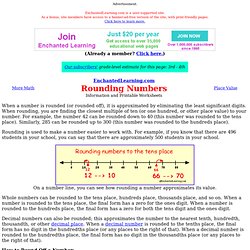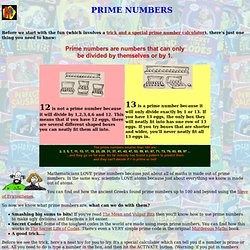

Mathtrain.TV Tutorvista.com - Online Tutoring, Homework Help for Math, Science, English from Best Online Tutor. Decimals: Place Value. Advertisement.

EnchantedLearning.com is a user-supported site. As a bonus, site members have access to a banner-ad-free version of the site, with print-friendly pages.Click here to learn more. (Already a member? Click here.) Place value is a positional system of notation in which the position of a number with respect to a point determines its value. Each position in a decimal number has a value that is a power of 10. The following chart shows the value of each place in a decimal number (written as a simple number, as an exponent, and in English): Worksheets to Print: Pre-Algebra - Math Learning Guides.
Greatest Common Factor. Rounding Numbers: EnchantedLearning. When a number is rounded (or rounded off), it is approximated by eliminating the least significant digits.

When rounding, you are finding the closest multiple of ten (or one hundred, or other place value) to your number. For example, the number 42 can be rounded down to 40 (this number was rounded to the tens place). Similarly, 285 can be rounded up to 300 (this number was rounded to the hundreds place). Rounding is used to make a number easier to work with. For example, if you know that there are 496 students in your school, you can say that there are approximately 500 students in your school. On a number line, you can see how rounding a number approximates its value. Whole numbers can be rounded to the tens place, hundreds place, thousands place, and so on.
Decimal numbers can also be rounded; this approximates the number to the nearest tenth, hundredth, thousandth, or other decimal place. How to Round Off a Number: Examples of Rounding numbers: Examples of Rounding Decimals: Snork's Long Division Game - KidsNumbers.com. Teach the Multiplication Facts - Times Tables. Beginning algebra - solve for x. Murderous Maths: Prime numbers! Before we start with the fun (which involves a trick and a special prime number calculator), there's just one thing you need to know: Prime numbers are numbers that can only be divided by themselves or by 1.

Mathematicians LOVE prime numbers because just about all of maths is made out of prime numbers. In the same way, scientists LOVE atoms because just about everything we know is made out of atoms. You can find out how the ancient Greeks found prime numbers up to 100 and beyond using the Sieve of Eratosthenes. So now we know what prime numbers are, what can we do with them? Smashing big sums to bits! Before we see the trick, here's a neat toy for you to try. Have you tried it out? What's the BIGGEST prime number you can find? The Prime Number Trick Using prime numbers, you can amaze your friends with a prime prediction...
There will be a remainder of 6. (Or if they do the sum on a calculator, the answer will end with " .5") The "24" Mystery! (6n+1)2 = 36n2+12n+1. . (6n-1)2 = 36n2-12n+1. Links: Houghton Mifflin Math Expressions: Grade 5—Teaching Tools—Visual Support. Ask Dr. Math - Elementary Archive. Cool Math 4 Kids Long Division Lesson and Practice Game.